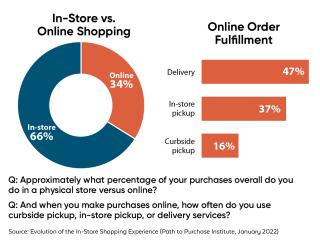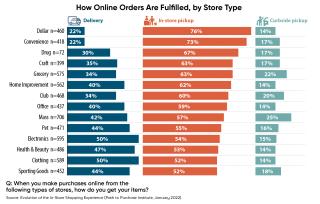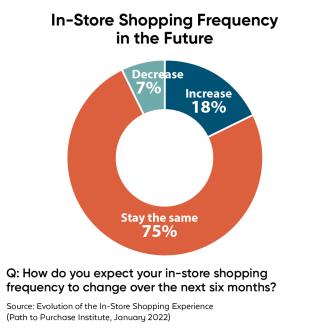The Evolution of the In-Store Shopping Experience, Part 1

(In cooperation with Great Northern Instore)
Even before the world was upended by the COVID-19 pandemic, the in-store shopping experience was drastically changing. Consumer online shopping habits were impacting the draw to physical retail, and brands were adjusting in-store marketing strategies to capture attention and deliver an exceptional experience. Since March 2020, consumers have continued to adapt their online and in-store shopping habits.
This custom research project was conducted in January 2022 as consumers navigated the height of the omicron variant. The intent was to delve into the transformation of the in-store experience and uncover opportunities for brands and retailers to engage consumers as more and more shoppers consider excursions to physical stores.
As the world is poised with hope in COVID-19 reaching an endemic status, how will the shopping habits consumers adopted the past two years impact their path to purchase in the immediate future?
This two-part special report, “The Evolution of the In-Store Shopping Experience,” offers insights into the current state of consumer shopping mindsets and habits. Part 1 looks at shopping frequency and changes in shopping habits, as well as in-store vs. online shopping preferences. In the May/June issue, part 2 will take an in-depth look at the in-store shopping experience, including reasons consumers are shopping in-store and what they are shopping for, the factors influencing their in-store experience, and the drivers for spontaneous purchases.
Shopping Frequency
Throughout the pandemic, grocery and non-food household essential retailers remained at the center of attention. From staffing and store cleanliness to stocking challenges and product purchase limits, the state of grocery was one of the shopping experiences making headline news.
Throughout the stages and variants of the pandemic, consumers were prioritizing their household and family essential needs. In addition to groceries and non-food items such as cleaning products and paper towels, this prioritization included food and supplies for furry family members. These categories are still going strong, topping the survey list of overall shopping frequency (items shopped for once a month or more), as well as a higher percentage of in-store shopping.
While these categories may seem evident areas of frequency, other notable items include alcoholic beverages, cannabis and medication. Not only do these categories top the list in overall frequency, but they also represent a higher percentage of shopping done in-store.
These frequency levels demonstrate opportunities for brands to continue to capture consumer attention and market share in-store. Understanding consumers’ mindsets while shopping and the changes in their shopping habits will help inform strategies to successfully capture their attention and elevate in-store experiences.
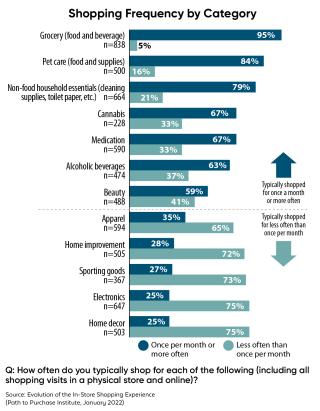
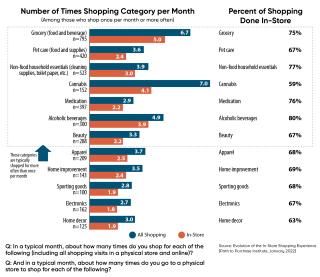
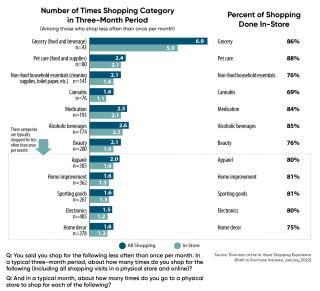
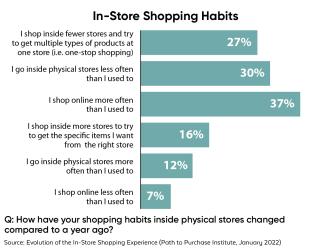
Change in Shopping Habits
Pre-pandemic shopping was more than a carefully planned trip for essential items. For many, it was more of an enjoyable experience amidst a community of people, an opportunity to be out in the world — sometimes just to browse. For some, it was part of a planned excursion that included lunch with friends. The enjoyment and entertainment aspects of shopping seem to be on hold for many still (especially at the time of this survey during the omicron wave of COVID-19), with in-store shopping viewed as a carefully timed and strategized trip. Safety is paramount as shoppers look to purchase as many necessities as possible in one location when the fewest number of people will be there, timed for the greatest probability for recently stocked inventories.
“It’s depressing now! It used to be a highlight, now I dread it,” said one respondent.
“Before I had no problem going from store to store,” said another respondent. “Now it’s different. I will shop at a store where I can get most of my items. I stay away from crowds and anyone without a mask.”
Safety & Cleanliness
While some respondents believe their habits have not changed from pre-pandemic circumstances, there is a clear concern for many about safety and cleanliness. The great mask debate prevails with responses on every side of the issue. Whether for or against masking up, shopping with a mask is clearly communicated as a major change in shopping habits. “Mask, mask, wearing a mask” was a repeated response to the question, “What has been the biggest change in your own experience shopping in-store now versus before the onset of the COVID-19 pandemic?”
“I am still very cautious shopping in-store,” said one respondent. “I am always looking around to make sure people are still distancing and wearing masks.”
Additional comments about safety and cleanliness include:
• “I am now more safety conscious.”
• “I’m more careful about touching things.”
• “I go early in the morning, so there are fewer people around and the store is clean.”
Efficiency
With many consumers concerned about safety and cleanliness, they are approaching shopping with a sense of urgency and efficiency. This is evident with the increase in one-stop-shopping at mass merchandisers and grocery stores.
One respondent said, “I go less often and buy more at one time.”
“I don’t shop in-store as often, and I usually am in there a shorter amount of time,” said another.
Several respondents commented that they “don’t look around” or “browse in stores like I used to.” Many reiterated it is now “an in-and-out experience.”
Socialization
Shopping was part of a lifestyle pre-pandemic, and over the past two years it has been made more of a chore. Due to the in-and-out, spend-as-little-time-in-the-store-as-possible mentality, positive impromptu interactions with strangers and polite customer service exchanges sadly seem to be missing. For some, the fun of shopping is a bit of a distant memory.
“Before the pandemic, there were a lot of people in the malls, stores, etc., enjoying themselves without having to worry about a virus or getting sick. Now everyone has to wear a mask and we can’t enjoy ourselves,” said one respondent. “It’s not fun anymore.”
Another respondent said, “I go to the store less often and spend less time there. I don’t shop with friends and go to lunch during a shopping trip.”
Others commented about “being on edge with fellow shoppers” or “being more cautious of the people around me and how close they are standing to me.”
“Customers are not as friendly now as they used to be. People avoid each other as much as possible,” said a respondent.
“There is more division and tension in the shopping environment,” said another.
The current state of shopping socialization can be summed up in the words of one respondent, “People seem less happy. There is a sense of frustration and isolation that detracts from the in-store experience.”
Supply, Demand & Customer Service
Another aspect of in-store shopping that has made consumers irritable is the availability of items on their list. They find themselves frustrated by the retailers as well as their fellow shoppers. They are noting the frequency of empty shelves and higher prices. Shoppers are also commenting on the labor shortage and customer service, highlighting the lack of help and attentive staff as well as longer checkout lines and wait times.
Here is a sampling of responses focused on supply, demand and customer service issues:
• “I am buying more carefully since there are shortages.”
• “A lot more things are harder to find because people take more than they need.”
• “A lot of products are not staying on the shelves.”
“Because of the supply chain issue, the usual items you buy are out of stock or on back order.”
• “Lack of items in stock, long lines and angrier atmosphere.”
• “Things being unavailable, changed store hours and not enough staff.”
The numerous concerns expressed by respondents, while definite obstacles for retailers, are also opportunities for innovation and raising the bar on experience. As retailers navigate hiring and supply chain challenges, the opportunity is how to address consumer concerns and reintroduce a positive, enjoyable experience where consumers feel safe and encouraged to connect again.
There is a social experiment aspect to consider as brands and retailers brainstorm shopping innovations — and how those might break down the divisive walls that people have built up between each other, help people positively embrace spontaneous interactions and simply find joy in shopping again.
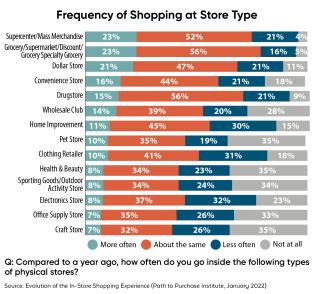
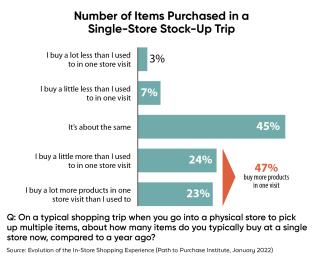
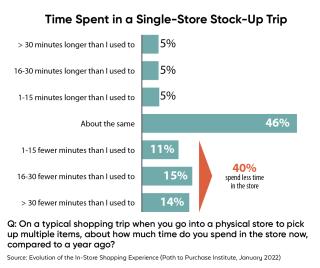
In-Store vs. Online Shopping
Today’s consumer has many choices when it comes to shopping. Not only can they choose online vs. in-store; they can choose delivery, in-store pickup or curbside pickup. Even as respondents were navigating the omicron variant, their responses to this survey show a positive outlook for brands and retailers to connect with shoppers in-store. Whether they are making a trip specifically to shop in-store or coming for an in-store pickup, retailers have the opportunity to make an impression and change perceptions about the in-store experience.
